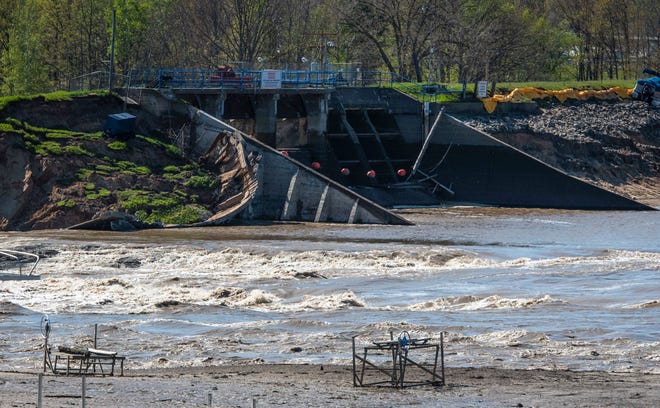Judge orders Edenville Dam owners to do immediate inspection to assess further risks
 Beth LeBlanc
Beth LeBlancA federal judge on Monday instructed the owners of the failed Edenville Dam to perform an immediate inspection of the structure to determine if it poses a substantial risk to folks downstream of the remaining Tobacco River segment.
U.S. District Judge Paul Maloney ordered the immediate inspection after the state alleged the dam company was "slow-walking" the inspection to the detriment of residents who could be harmed by a second breach in the dam.

Lawrence Kogan, a lawyer for dam owner Boyce Hydro Power, filed an engineering report on the dam segment Monday morning, noting tension cracks, erosion and sloughing on the Tobacco River side of the dam.
But Maloney, an appointee of former President George W. Bush, appears to want a new one by Friday to determine whether immediate action is needed to protect public health.
Maloney ordered the inspection Monday shortly he denied state agencies' request to transfer their June 9 suit for flood damages out of his court, where it had been moved, along with the state's May 1 mussel damages lawsuit, from Ingham County Circuit Court.
"While at first glance the complaint presents only state law claims, there are substantial 'federal ingredients' lurking in the allegations that must be considered as part of the ultimate analysis such that this court has jurisdiction to hear this case," Maloney wrote Monday.
The ongoing suits were spurred by the May 19 breach of the Edenville Dam amid historic rains and after years of failed attempts to bring the infrastructure in line with federal and state regulations. The dam's failure led waters from the Tittabawassee River to surge downstream, where they overtopped the Sanford Dam and caused significant flooding throughout the Midland area.
Three days after the dam broke, on May 22, EGLE handed Boyce an emergency inspection order to evaluate the state of the dam on the Tobacco River side and large cracks in the structure by May 24.
When Boyce failed to respond, EGLE on June 2 gave Boyce a new deadline of June 3 and the company instead responded it would be on site the week of June 8. EGLE is not sure the inspection took place and no findings were reported, according to Maloney's report.
Not only are there alleged 60-foot cracks in the Tobacco River side of the structure, but residents have also been walking in the destroyed area to recover lost property, Maloney said.
He also noted that the remaining segment of the Edenville Dam is holding back "a substantial amount of water" and diverting the flow of the Tobacco River so that repairing M-30 is nearly impossible.
"If another storm were to come through the area, the damaged dam presents a grave risk to property and public health," Maloney said while granting the state's request for an order to force the inspection.
"Defendants have slow-walked their response, without regard to the possibility that now-damaged dam could cause another mass flooding event," the judge said.
Boyce must report by Friday whether the dam's risk is substantial enough to merit immediate action, and must prepare a more comprehensive report on the dam structure by July 24.
Kogan said the company would comply with Maloney's orders, but he noted that Boyce had already filed an engineering report completed Sunday.
The report from TRC Engineers Inc., filed Monday, said it inspected the Tobacco River side of the Edenville Dam with the state's dam safety engineer Dan DeVaun on Wednesday.
TRC reported there were tension cracks and surface sloughing near the downstream slope of the Tobacco Spillway, believed to be caused by erosion damage and ground softened by the rain and waves in mid-May. The engineering company said the slope appeared to be stable but recommended Boyce monitor it weekly.
The company also reported "a significant length" of the upstream slope of the dam was being eroded by the Tobacco River — so much so that TRC recommended the construction of a temporary sheet pile wall upstream to move the water away from the dam and into the original stream path.
eleblanc@detroitnews.com